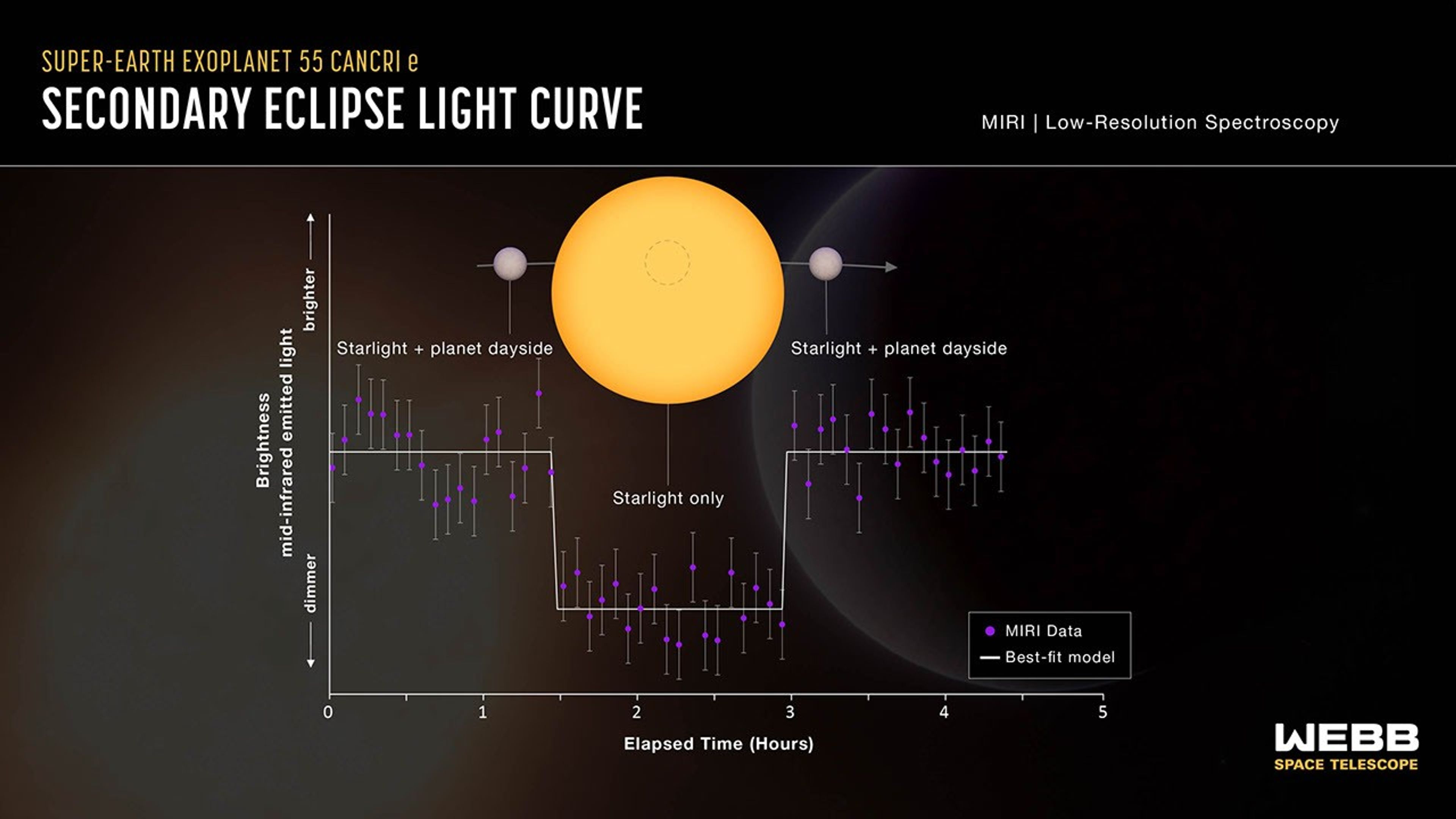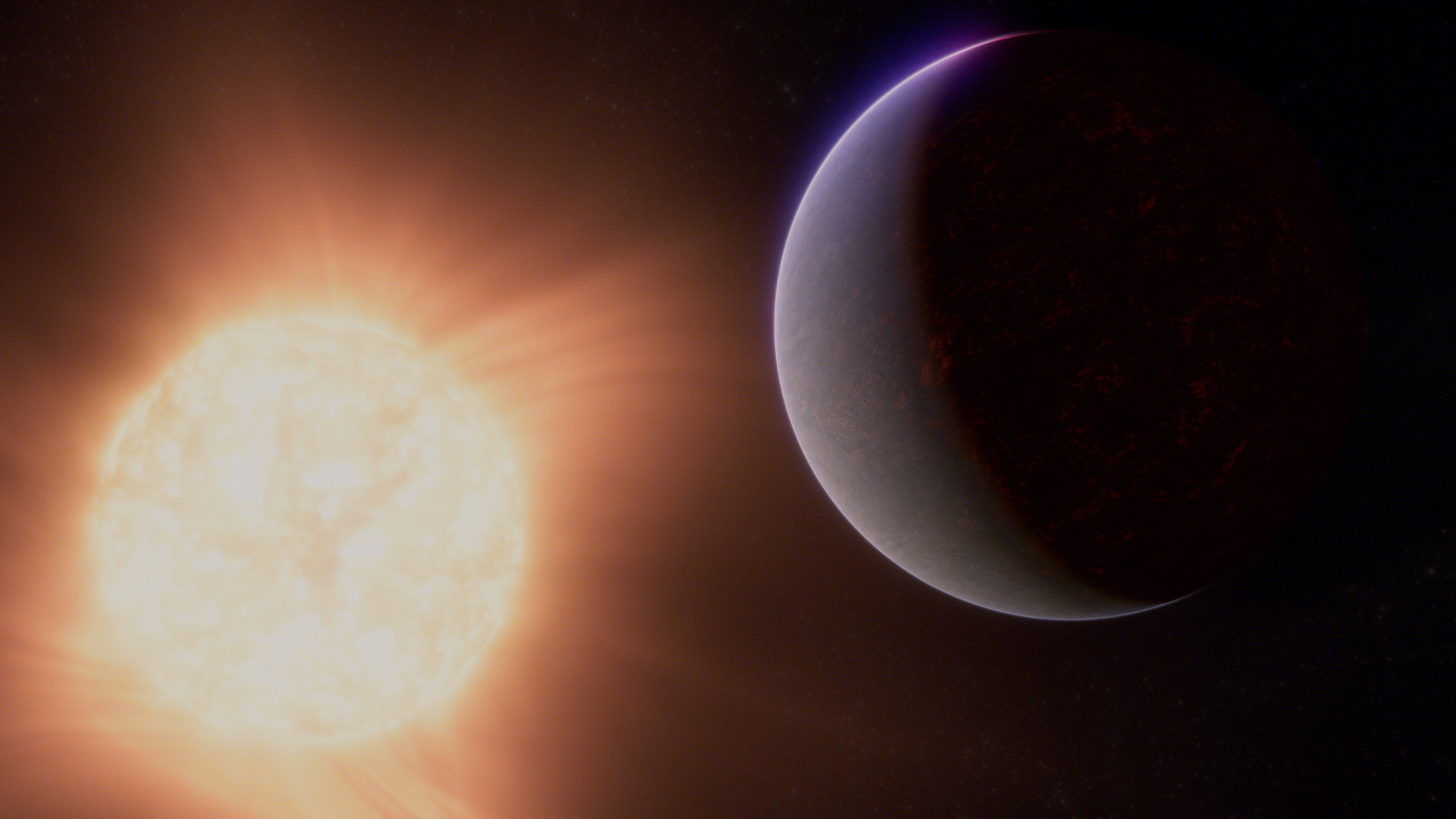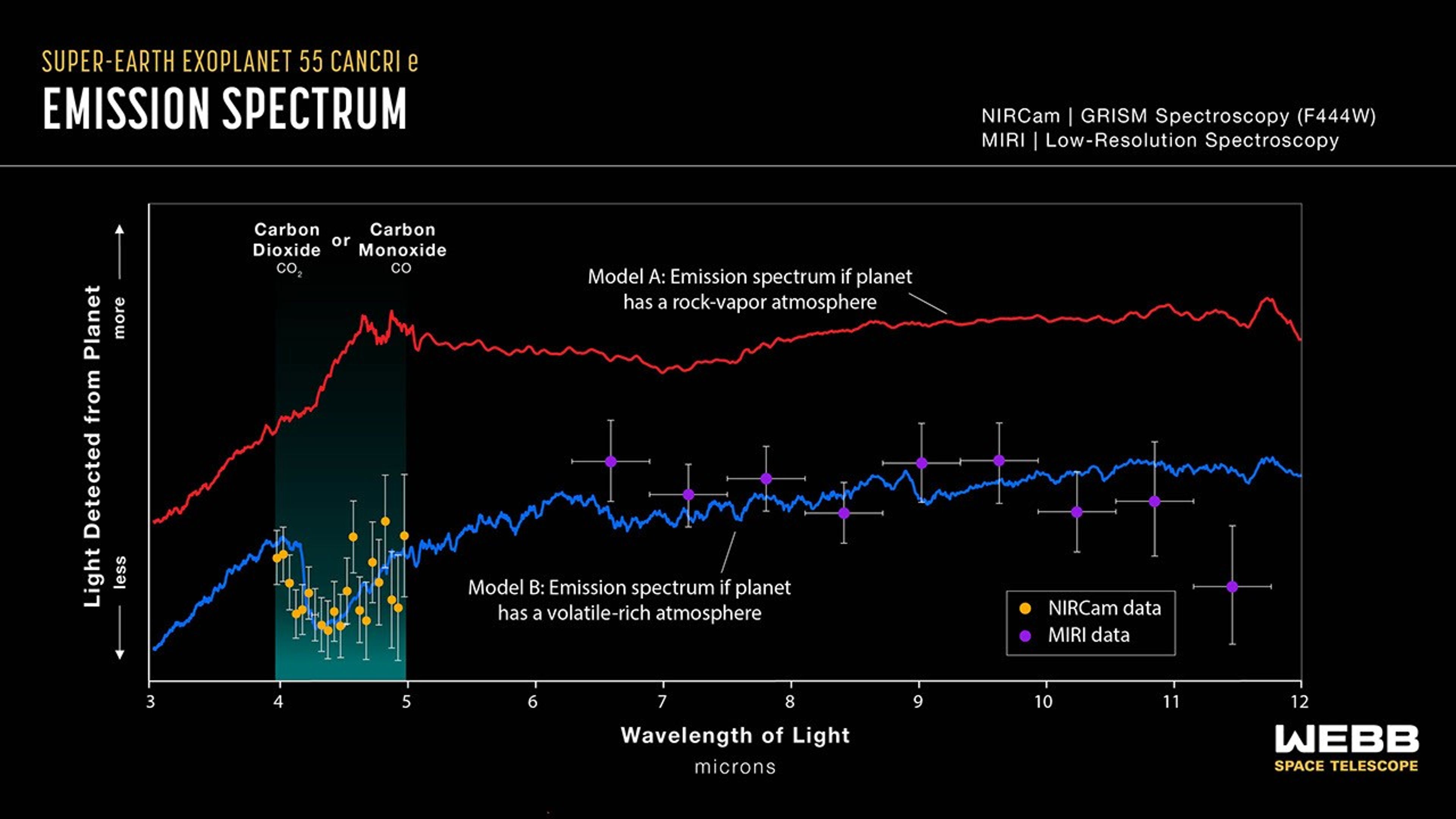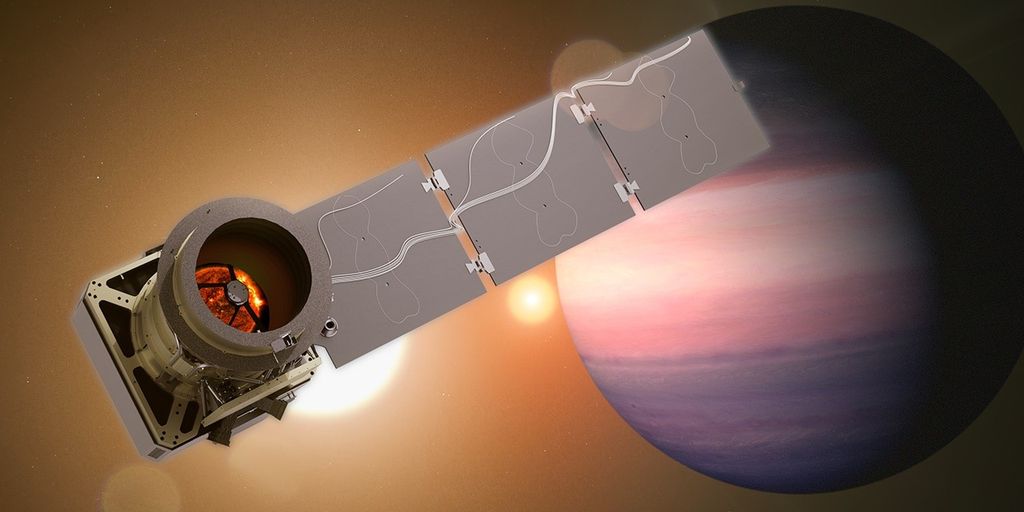1 min read
Super-Earth Exoplanet 55 Cancri e (MIRI Secondary Eclipse Light Curve)

This light curve shows the change in brightness of the 55 Cancri system as the rocky planet 55 Cancri e, the closest of the five known planets in the system, moves behind the star. This phenomenon is known a secondary eclipse.
When the planet is next to the star, the mid-infrared light emitted by both the star and the dayside of the planet reaches the telescope, and the system appears brighter. When the planet is behind the star, the light emitted by the planet is blocked and only the starlight reaches the telescope, causing the apparent brightness to decrease.
Astronomers can subtract the brightness of the star from the combined brightness of the star and planet to calculate how much infrared light is coming from the dayside of the planet. This is then used to calculate the dayside temperature and infer whether or not the planet has an atmosphere.
The graph shows data collected using the low-resolution spectroscopy mode on Webb’s Mid-Infrared Instrument in March 2023. Each of the purple data points shows the brightness of light ranging in wavelength from 7.5 to 11.8 microns, averaged over intervals of about 5 minutes. The grey line is the best fit, or model light curve that matches the data most closely. The decrease in brightness during the secondary eclipse is just 110 parts per million, or about 0.011 percent.
The temperature of the planet calculated from this observation is about 1,800 kelvins (around 2,800 degrees Fahrenheit), which is significantly lower than would be expected if the planet has no atmosphere or only a thin rock-vapor atmosphere. This relatively low temperature indicates that heat is being distributed from the dayside to the nightside of the planet, possibly by a volatile-rich atmosphere.
Extended Description and Image Alt Text
Extended Description
Infographic titled “Super-Earth Exoplanet 55 Cancri e Secondary Eclipse Light Curve, MIRI Low-Resolution Spectroscopy.”
The graphic has two parts. At the top is a diagram showing a planet moving behind its star (a secondary eclipse). Below the diagram is a graph showing the change in relative brightness of the star-planet system over time. The diagram and graph are aligned vertically to show the relationship between the geometry of the star-planet system as the planet orbits, and the measurements on the graph.
Diagram of Secondary Eclipse
At the center is a bright yellow-orange circle representing the star. A thin gray line with an arrow pointing to the right represents a portion of the orbital path of the planet. Along the gray line, and on either side of the star, is a gray circle. These represent the planet before (at left) and after (right) it moves behind the star. Along the line, in the middle of the star is an open circle with a dashed outline representing the position of the planet in the middle of the secondary eclipse, when it is behind the star. The star and planet are not to scale.
Graph
Below the secondary eclipse diagram is a graph of Brightness of mid-infrared emitted light on the vertical y-axis versus Elapsed Time in hours on the horizontal x-axis.
Axes
The y-axis ranges from dimmer at the bottom to brighter at the top. There are no units or tick marks. The x-axis ranges from 0 hours at the origin on the left to 5 hours at the far right. There are labeled tick marks every hour.
Key
The graph includes a key showing that purple circles are MIRI data and the white line represents a best-fit model.
Data
The graph consists of 53 brightness measurements plotted as solid purple circles with vertical grey error bars. The points are not connected. The brightness shows slight increases and decreases between 0 and about 1.5 hours. At 1. 5 hours, the brightness decreases significantly, and stays relatively low until about 3 hours, where it rises back to its original level. Between 3 and 4.5 hours, the brightness again shows slight increases and decreases.
Model
A best fit model is shown as a thin white line running left to right across the graph. The line forms a deep U-shaped valley in the center, with flat plains on either side. The valley has steep sides and a flat floor. It begins at about 1.5 hours and ends at about 3 hours. The line intersects some, but not all, of the purple brightness measurements and grey error bars.
Labels
There are three labels above the data points and the model. The label in the center, above the dim, U-shaped section of the model and data points, is labeled “Starlight only.” The brighter sets of measurements on the left and right sides of the graph are both labeled, “Starlight + planet dayside.”
Relationship between the Diagram and Graph
Vertical gray lines connect each of the three planet positions in the diagram to the corresponding portions of the light curve. From left to right: 1) Before the planet begins to move behind the star, the brightness is relatively high; 2) When the entire planet is behind the star and the brightness is at its lowest point (the center of the U-shaped valley); 3) When the planet has moved out from behind the star, the brightness has increased back to the level it was before the decrease.
Image Alt Text
Infographic titled “Super-Earth Exoplanet 55 Cancri e Secondary Eclipse Light Curve” showing a diagram of a secondary eclipse and a graph of change in brightness over time.
About the Object
- R.A. PositionR.A. PositionRight ascension – analogous to longitude – is one component of an object's position.08h52m35.24s
- Dec. PositionDec. PositionDeclination – analogous to latitude – is one component of an object's position.+28d19m47.34s
- ConstellationConstellationOne of 88 recognized regions of the celestial sphere in which the object appears.Cancer
- DistanceDistanceThe physical distance from Earth to the astronomical object. Distances within our solar system are usually measured in Astronomical Units (AU). Distances between stars are usually measured in light-years. Interstellar distances can also be measured in parsecs.41 light-years
About the Data
- Data DescriptionData DescriptionProposal: A description of the observations, their scientific justification, and the links to the data available in the science archive.
Science Team: The astronomers who planned the observations and analyzed the data. "PI" refers to the Principal Investigator.MIRI low-resolution time-series spectroscopy (5-12 microns)
- InstrumentInstrumentThe science instrument used to produce the data.MIRI
- Exposure DatesExposure DatesThe date(s) that the telescope made its observations and the total exposure time.March 24, 2023
- Object NameObject NameA name or catalog number that astronomers use to identify an astronomical object.Planet: 55 Cancri e, also called Janssen; Star: 55 Cancri, also called Rho-1 Cancri, Copernicus
- Object DescriptionObject DescriptionThe type of astronomical object.Super-Earth Exoplanet orbiting a K-Star
- Release DateMay 8, 2024
- Science ReleaseNASA’s Webb Hints at Possible Atmosphere Surrounding Rocky Exoplanet
- CreditIllustration: NASA, ESA, CSA, Joseph Olmsted (STScI); Science: Aaron Bello-Arufe (NASA-JPL)
Related Images & Videos

Super-Earth Exoplanet 55 Cancri e (Artist's Concept)
This artist’s concept shows what the exoplanet 55 Cancri e could look like. Also called Janssen, 55 Cancri e is a so-called super-Earth, a rocky planet significantly larger than Earth but smaller than Neptune, which orbits its star at a distance of only 1.4 million miles (0.015...

Super-Earth Exoplanet 55 Cancri e (NIRCam + MIRI Emission Spectrum)
A thermal emission spectrum captured by Webb’s NIRCam (Near-Infrared Camera) in November 2022, and MIRI (Mid-Infrared Instrument) in March 2023, shows the brightness ( y -axis) of different wavelengths of infrared light ( x -axis) emitted by the super-Earth exoplanet 55 Cancri e...
Share
Details
Laura Betz
NASA’s Goddard Space Flight Center
Greenbelt, Maryland
laura.e.betz@nasa.gov
NASA, ESA, CSA, Joseph Olmsted (STScI)
Aaron Bello-Arufe (NASA-JPL)































